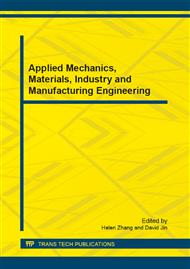[1]
L. A. Rodriguesa, M. L. C. P. Silva, M. O. Alvarez-Mendes, A. R. Coutinho, G. P. Thim, Phenol removal from aqueous solution by activated carbon produced from avocado kernel seeds, Chemical Engineering Journal Vol. 174 (2011), pp.49-57.
DOI: 10.1016/j.cej.2011.08.027
Google Scholar
[2]
A. C. Lua, Q. P. Jia, Adsorption of phenol by oil–palm-shell activated carbons in a fixed bed , Chemical Engineering Journal Vol. 150 (2009) , pp.455-461.
DOI: 10.1016/j.cej.2009.01.034
Google Scholar
[3]
M.L. Leong, K.M. Lee , S.O. Lai, B.S. Ooi , Sludge characteristics and performances of the sequencing batch reactor at different influent phenol concentrations, Desalination, Vol. 270 (2011) pp.181-187.
DOI: 10.1016/j.desal.2010.11.043
Google Scholar
[4]
R.M. Aghav, Sunil Kumar, S.N. Mukherjee, Artificial neural network modeling in competitive adsorption of phenol and resorcinol from water environment using some carbonaceous adsorbents, Journal of Hazardous Materials Vol. 188 (2011) , pp.67-77.
DOI: 10.1016/j.jhazmat.2011.01.067
Google Scholar
[5]
Y. J. Wang, J. Song, W. Zhao, X.L. He, J. Chen, M. Xiao, In situ degradation of phenol and promotion of plant growth in contaminated environments by a single Pseudomonas aeruginosa strain, Journal of Hazardous Materials Vol. 192 (2011) pp.354-360.
DOI: 10.1016/j.jhazmat.2011.05.031
Google Scholar
[6]
S. Nosrati, N.S. Jayakumar, M.A. Hashim, Performance evaluation of supported ionic liquid membrane for removal of phenol, Journal of Hazardous Materials Vol. 192 (2011) pp.1283-1290.
DOI: 10.1016/j.jhazmat.2011.06.037
Google Scholar
[7]
Rushdi I, Yousef, Bassam El-Eswed, Ala H. Al-Muhtaseb, Adsorption characteristics of natural zeolites as solid adsorbents for phenol removal from aqueous solutions: Kinetics, mechanism, and thermodynamics studies, Chemical Engineering Journal Vol. 171 (2011).
DOI: 10.1016/j.cej.2011.05.012
Google Scholar
[8]
S. Kumar, M. Zafar, J. K. Prajapati, S. Kumar, S. Kannepalli, Modeling studies on simultaneous adsorption of phenol and resorcinol onto granular activated carbon from simulated aqueous solution, Journal of Hazardous Materials Vol. 185 (2011).
DOI: 10.1016/j.jhazmat.2010.09.032
Google Scholar
[9]
T. Luenloi, B. Chalermsinsuwan, T. Sreethawong, N. Hinchiranan, Photodegradation of phenol catalyzed by TiO2 coated on acrylic sheets: Kinetics and factorial design analysis, Desalination Vol. 274 (2011) , pp.192-199.
DOI: 10.1016/j.desal.2011.02.011
Google Scholar
[10]
P. R. Shukla, S. B. Wang, H. Q. Sun, H. Ming Ang, M. Tadé, Activated carbon supported cobalt catalysts for advanced oxidation of organic contaminants in aqueous solution, Applied Catalysis B: Environmental Vol. 100 (2010) , pp.529-534.
DOI: 10.1016/j.apcatb.2010.09.006
Google Scholar
[11]
R. Alnaizy, A. Akgerman, Advanced oxidation of phenolic compounds, Advances in Environmental Research Vol. 4 (2000) , pp.233-244.
DOI: 10.1016/s1093-0191(00)00024-1
Google Scholar
[12]
A. Bódalo, E. Gómez, A.M. Hidalgo, M. Gómez, M.D. Murcia, I. López, Nanofiltration membranes to reduce phenol concentration in wastewater , Desalination Vol. 245 (2009) , pp.680-686.
DOI: 10.1016/j.desal.2009.02.037
Google Scholar
[13]
T. A. Enache, A. M. Oliveira-Brett, Phenol and para-substituted phenols electrochemical oxidation pathways, Journal of Electroanalytical Chemistry Vol. 655 (2011) , p.9–16.
DOI: 10.1016/j.jelechem.2011.02.022
Google Scholar
[14]
J. J. Wei, X. P. Zhu, J.R. Ni,Electrochemical oxidation of phenol at boron-doped diamond electrode in pulse current mode, Electrochimica Acta Vol. 56 (2011), p.5310–5315.
DOI: 10.1016/j.electacta.2011.04.006
Google Scholar
[15]
Z. L. Wu, M. Franke, B. Ondruschka, Y. C. Zhang, Y.L. Ren,P. Braeutigam, W. M Wang, Enhanced effect of suction-cavitation on the ozonation of phenol, Journal of Hazardous Materials Vol. 190 (2011) , pp.375-380.
DOI: 10.1016/j.jhazmat.2011.03.054
Google Scholar


